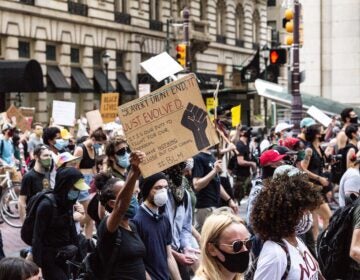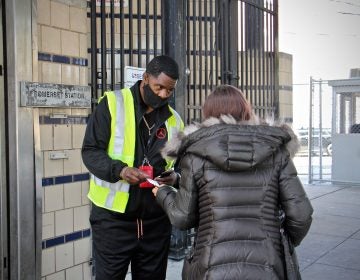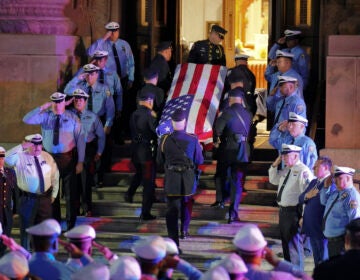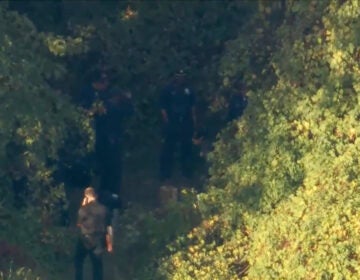Why is it still so hard to see police bodycam footage in Pennsylvania?
For the general public, getting a glimpse of any body or dashcam footage is a rare feat, partly thanks to a Pennsylvania law that makes it hard to access.
Listen 2:09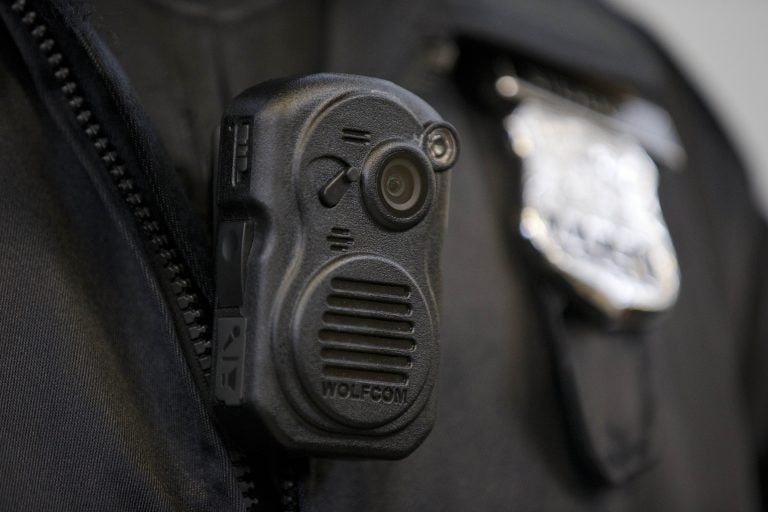
In this file photo, a Philadelphia Police officer demonstrates a body camera used as part of a pilot project in December 2014 in Philadelphia. (Matt Rourke/AP Photo)
Police body cameras are a rare tool that can help secure criminal convictions and hold police officers accountable. The recordings theoretically make it harder for police to lie about what happened, and, in turn, for citizens to lie about police.
“It is an absolute key to police accountability,” said Philadelphia District Attorney Larry Krasner, describing the dual benefits in an interview with WHYY. “And it’s an absolute key to our ability to prove cases against people who have committed crimes.”
But for the general public, getting a glimpse of any body or dashcam footage is a rare feat, partly thanks to a Pennsylvania law that intentionally makes it hard to access.
While Pennsylvania’s restrictions on police footage aren’t necessarily worse than other states, advocates say access could and should be improved. Some have filed legal challenges or introduced legislation to loosen guidelines, and the governor says he’s open to reviewing or revising the laws.
The Walter Wallace Jr. shooting last fall marked the first time video of a police shooting was released by Philadelphia Police Department, ever. Although Wallace’s family asked for its release, it was voluntarily made public by the PPD and DAO — rather than through this formal request process.
Introduced in Philly in 2014, bodycams are worn by a little over half the city’s patrol officers. But ADA Tracy Tripp, who heads the DAO’s Special Investigations Unit, has never even received a request to see footage from the cameras.
“I am the one who would get those requests,” Tripp said. “And I have never gotten one.”
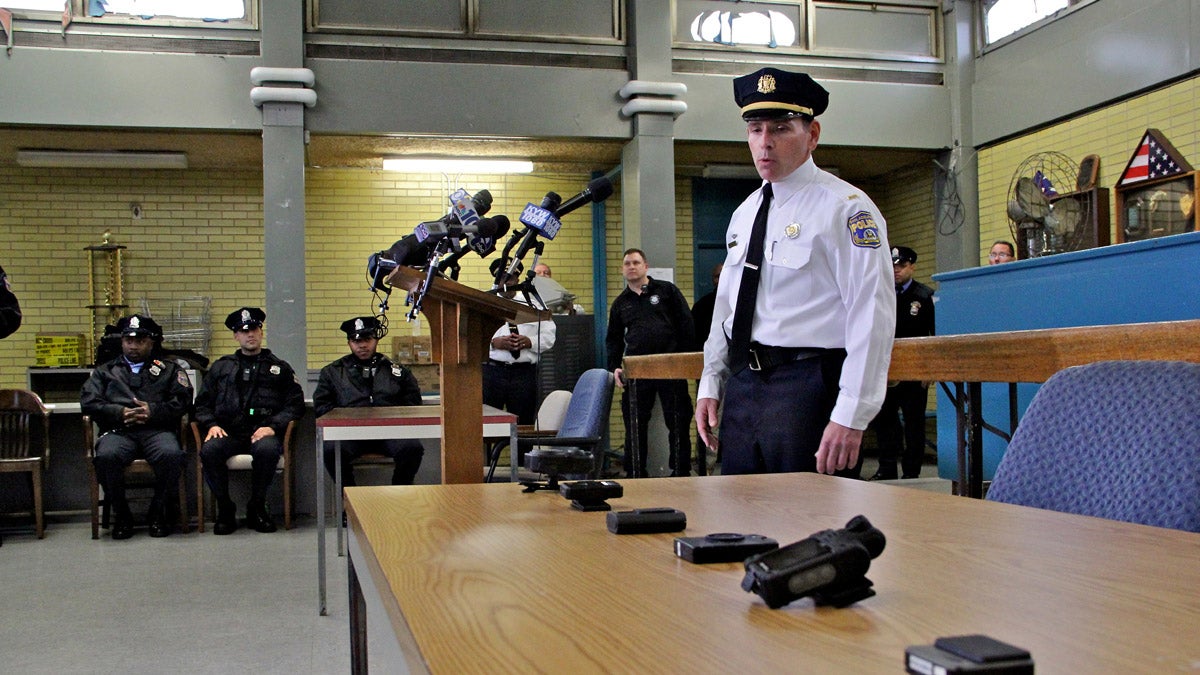
Why not? Tripp cited the convoluted and time-consuming requirements of the state transparency law, called Act 22. For example, applicants must submit requesting forms in person or via certified mail. And they have to do it within 60 days of an incident.
“Requests must be submitted via personal delivery or certified mail — Well, that’s silly, right? And why is there a 60-day time limit there? That seems arbitrary,” Tripp said. “I think there does need to be a high bar, but I don’t think it needs to be an impossible bar.”
That Tripp hasn’t seen any requests doesn’t necessarily mean zero people have asked, however. What she does know is that police have never forwarded any to her.
PPD spokesperson Sgt. Eric Gripp said the office had received 19 requests for video since 2017, but said none were ever forwarded to the DAO. That’s an important detail because the DAO has final say over release of any footage that becomes evidence in a criminal investigation –– potentially anything from videos of police shootings to clashes between cops and protestors.
“The [PPD] does not have a memorandum of understanding with the Philadelphia District Attorney’s office to review Act 22 body camera requests, nor is it required to under the Act,” said.
Open records advocates say this is part of the problem with Act 22: it defers to police departments, which can work against the stated purpose of equipping officers with cameras.
“It doesn’t work. You’re at the mercy of the police department,” said Paula Knudsen Burke, a Pennsylvania-based attorney for the Reporters Committee for Freedom of the Press. “The entire law could use review.”
Some in Pennsylvania say change is long overdue.
“Think of how challenging the George Floyd case could have been if no one had videotaped it,” said Pennsylvania State Rep. Dan Miller, who has authored legislation to loosen access to police videos. “There’s no point in police recording everything if the public never gets to see it, or has to jump through all these hoops to see it.”
Others aren’t waiting for new legislation. Terry Mutchler, a Dilworth Paxon attorney and onetime director of the state’s Office of Open Records, is currently representing reporters seeking bodycam footage in one of the first legal challenges to the law.
She says the decision could set a far-reaching precedent for how the system works in Pennsylvania.
“[Act 22] is a signature open records law and yet there’s no case law here,” Mutchler said. “This is a critical time to carve out what Act 22 means, in practical terms.”
Open and shut
For a few weeks, Pennsylvania had some of the best laws around access to police footage in the country.
In June 2017, the Pennsylvania Supreme Court issued a ruling in favor of a Centre County woman who sought State Police dashcam footage of a car crash involving her friend. The case, which dragged on for three years, drew resistance from the state troopers, but ultimately the court ruled dash and bodycam video should be considered public records. In other words, the burden was on law enforcement to show why video should be withheld.
That ruling stood for less than a month. Before the court handed down its opinion, state legislators had already written and passed the legislation now known as Act 22. A few weeks after the court decision, Governor Tom Wolf signed the bill into a law, explicitly removing police video from the state’s right-to-know system.
It created the new system in use today, which requires people seeking bodycam footage to:
- Submit a request within two months
- Disclose their “relationship” to a particular incident, effectively telling police not just what a person is seeking, but also why they’re interested
- For incidents that occurred inside a residence, list the names of everyone present — a tricky feat for footage that may never have been glimpsed before
Further, if a department denies a request, applicants must pay a $125 fee to appeal the decision. And that appeal happens before a judge, rather than to the state’s Office of Open Records.
Burke says the time limit is particularly troubling because it allows departments to get rid of video footage relatively quickly, even though questions about an encounter might only emerge later on. With departments inclined to simply deny virtually all requests, a lengthy court appeals process served as an additional obstacle to many applicants.
“It’s a much narrower window of time and a much more onerous appeal process because you have to go to court,” Burke said.
Videos made public in ‘extraordinary’ circumstances
Today, in instances when police video is made public, such as high-profile police shootings like those that led to the death of Walter Wallace Jr. in Philadelphia or Ricardo Muñoz in Lancaster, this is often because departments voluntarily release footage.
The decision is often driven by public reaction, and the impact the release of video could have on the department.
PPD spokesperson Eric Gripp said there are sometimes good reasons for departments to withhold video. It could contain potential evidence in a yet-to-be-investigated criminal matter, he said. Or family members and defense attorneys might object to the release. The District Attorney’s Office could also raise objections.
In the case of Walter Wallace Jr., Gripp said, the release was agreed to by the DAO, the city Law Department and also, the Wallace family and their attorneys. “And the family asked for its release,” he added. “The Wallace shooting was an extraordinary circumstance … during an extraordinary time for our country and city.”
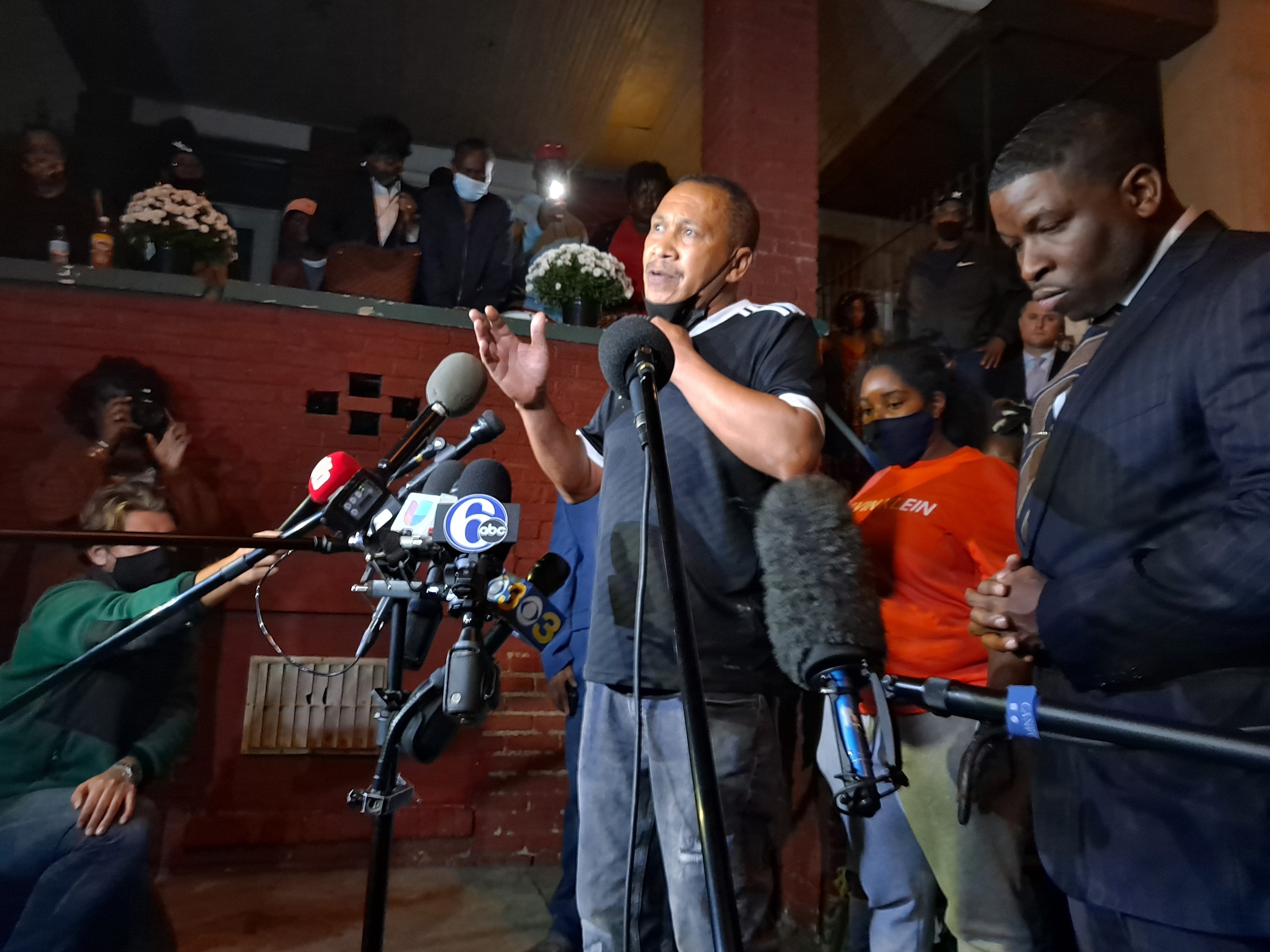
It was a rare exception.
The city’s most recent police shooting involved a man named James Alexander, who was shot and killed after a car stop in the Logan neighborhood last month. Police said he pulled a gun, jumped out of the vehicle, and fired several rounds at officers. He was a fugitive, police added, fearful of returning to prison and one of the officers had apparently been shot.
But the official account quickly changed. The officers that had initiated the stop — allegedly after the driver of the vehicle had blown a stop sign on a stretch of road with now obvious stop signs — had gotten a hit on a warrant for a different James Alexander. Some family members organized a vigil and said police were lying about how the shooting went down.
“My nephew did not have any warrants,” said Ishea Cedeno, Alexander’s aunt, at the time. “He was not wanted, he got out to run and was killed.”
Asked by reporters, the department declined to make the video public and indicated they had no plans to do so. Police and the DAO stated that the video had later been shown to Alexander’s parents, who had asked the footage not be made public.
“If, you know, my son, heaven forbid, was shot to death by a police officer and the video didn’t just include the actions before the death and at the time of the killing, but the video also included pretty grisly footage of someone who was either dead or dying and bleeding … I might have something to say about it [being released],” Krasner said.
And, in places like Philadelphia, that’s all assuming video is ever recorded at all.
The PPD says just 2,350 out of 4,300 street-facing officers carry cameras. Although Gripp says the plan is to eventually deploy cameras across the force, specialized units, like Narcotics, still don’t use them at all.
The DAO says there are also still issues with how long footage is stored and the way cameras are used by officers, from inaccurately tagging archived footage to failing to turn on the cameras in the first place — accidentally or not.
“There are deliberate behaviors to defeat body cameras, such as deliberately turning away from someone being beaten, coded conversations, turning off a camera when a supervisor says something they shouldn’t say,” Krasner says. “We would like to see that treated for what it is, which is obstructing the administration of justice and destruction of evidence.”
Calls for more transparency
Gov. Wolf’s spokesperson said he had signed Act 22 into law as written because it was “as far as the legislature was willing to go” at the time. But today, his office said it would be open to re-examining those laws.
“The governor supported — and still supports — further steps towards transparency with police bodycam footage,” spokesperson Lyndsay Kensinger said. “He supports legislative reforms, including legislation that would provide for improved access to police videos.”
Some lawmakers, like Pittsburgh-area Democratic state Rep. Miller and Rep. Austin Davis, have floated bills to reverse Act 22 by returning body and dashcam footage requests to the state’s right-to-know system, and triple the window of time for requests to six months.
Miller said he had heard some legitimate concerns from law enforcement groups over technical barriers, like the costs of storing large amounts of raw video data for months.
“There clearly are hardware and software costs. We believe there are some regional costs that could be shared,” Miller said. “We have a lot of small departments and having so many does raise a lot of questions. But I think they’re all surmountable.”
Miller had introduced similar legislation last year, thinking the murder of George Floyd might bring the political momentum needed to push through the reform. He reintroduced it in February but says it’s currently stuck in committee. (House Judiciary Chair Rob Kauffman declined to answer questions for this article.)
In the meantime, Mutchler, the Dilworth Paxon attorney, is testing Act 22 in state courts. The lawyer is representing requesters in one of the first formal appeals ever filed.

Mutchler is representing reporters in Lancaster seeking police footage of a protest that took place in the immediate aftermath of the Muñoz shooting — itself another instance of voluntary release of bodycam video, which showed the man, who had been diagnosed with bipolar disorder, lunging at a police officer with a knife.
The protest, outside a Lancaster police station last September, turned violent and police clashed with activists. The incident happened in a public area and news crews partially filmed it, but still, when a LancasterOnline reporter later sought bodycam footage of the incident, the department denied the request.
In Lancaster, she said the police force had, at one time, voluntarily turned over footage to reporters with some regularity. But Mutchler said something changed last summer, as outcry and scrutiny over police departments intensified.
“It reached a point where the significance of this case changed [the police’s] approach,” she said. “Instead of providing hours of footage, which they had in the past, everything got shut down. But you can’t just lock the door and say ‘Nobody gets in until all this is all over.’”
Mutchler says the outcome of the case could set an important precedent: whether Act 22 is, in fact, an obstacle to accessing footage or a clear avenue to accessing footage that can safely be made public. She described the law as “misunderstood” and said discussion about it often mischaracterized the underlying issue.
“It’s been framed as pro- or anti-law enforcement. But nothing is further from the truth,” she said. “It’s about transparency, it’s seeking a public record … And we have to decide if this law is a window into obtaining practical information or if the shade is going to be pulled down.”

Subscribe to PlanPhilly
WHYY is your source for fact-based, in-depth journalism and information. As a nonprofit organization, we rely on financial support from readers like you. Please give today.


